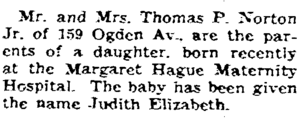Birth notices or birth announcements can be another source of information in genealogy research. This information can help lead to locating the actual vital records.
History of birth notices
Almost since the beginning of time, man has found ways to spread the word about a new birth. Initially, the announcement of a new birth spread through a small, local community by word of mouth, handwritten letters, and local notices. As communities became larger newspapers took a more important role in spreading the birth information. In the United States, these announcements have been included in newspapers since the early 1700s.
Types of birth notices
Newspapers
Birth announcement content in newspapers evolved depending on the time period, the newspaper, and the location. Initially, the announcements were brief and contained basic information like the child's name, date of birth, and parents' names.

Some newspapers, especially in the twentieth century, included hospital lists of babies born and included the names of the parents and their addresses. Small-town newspapers also provided interesting information about people in the community.
As newspapers developed and printing technology improved, birth announcements became a part of the “society column” in many towns. These society columns were the equivalent of today’s social media and covered interesting stories of residents regarding family events and reunions, town events, parties, marriages, school events, and local gossip. Additional information that may have been added to the society birth announcements may include the baby’s weight and length, birth location, grandparents’ names, additional family information, and may have even included a photo.

For many generations, it was common to find birth announcements published in newspapers. Today it is rare to find birth announcements in newspapers other than for famous people or births under unusual circumstances.
Letters, cards, post cards, and stationary
Newspapers in the early 1700s were only distributed locally. To notify distant family and friends of a new birth, the proud parents (or grandparents) would rely on a letter to make the announcement. As time went on, personalized birth announcements became more popular. Through the years, greeting card companies have offered a wide variety of pre-made birth announcements. The introduction and the rapid development of personal computers greatly increased the variety and content of birth announcements. The personal notes found in these announcements may contain detailed family information, personal stories, or photographs. Printed birth announcements are still popular today.
Social media

Unlike newspaper or printed birth announcements, today’s online social media provides almost instantaneous notification of a new birth to almost anywhere around the world. Digital announcements also allow for almost unlimited space to share details, photos, and videos. Digital platforms such as Facebook, Instagram, and X, (formerly known as Twitter) allow for instant comments by family and friends. Digital cloud storage services now allow these online birth announcements to be stored indefinitely and can be easily accessible for future genealogy research.
With the broad access of all of these modern online social media platforms comes new privacy and security concerns which must be of concern to today’s genealogists.
Why use birth notices in genealogy research
Some of the reasons to use birth announcements in your genealogy research:
- Birth announcements in old newspapers may contain old photographs of your family members that you have never seen
- Stories included in some of the society announcements may contain additional family lifestyle information, social customs, and event dates
- Newspaper birth announcements may serve as a substitute for civil records that were destroyed by fires or natural disasters
- You may be able to find information on children born and/or died between censuses
Tips for using birth notices in genealogy research
- Identify local newspapers: Search newspapers at the times and in known areas where your ancestors lived when searching historical newspaper archives, online and offline.
- Use available search tools: Many online newspaper databases offer keyword search functionalities, allowing you to search by names, dates, and locations.
- Look at other details: Don't just rely on keywords like "birth announcement." Explore other sections of the newspaper, such as social announcements or birth columns.
See also
Explore more about birth notices
- Newspapers collection catalog at MyHeritage
- OldNews by MyHeritage
- Library of Congress’ Chronicling America
Additionally, it is recommended to check out state and county historical societies and libraries. Many of these repositories have microfilm papers, some of which have been digitized or indexed.